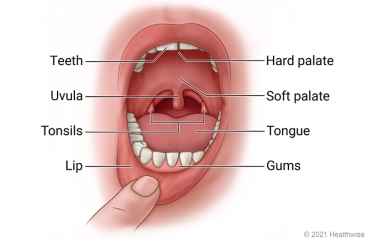
Your Care Instructions
Mouth injuries are common. They may involve the teeth, jaw, lips, tongue, inner cheeks, or gums. A mouth injury can also affect the roof of the mouth, your neck, or your tonsils.
You may injure your teeth during a fall or while playing sports. An injury can crack, chip, or break a tooth or make a tooth change color. A tooth also may be knocked out, loosened, moved, or jammed into the gum.
An injury to the roof of your mouth, the back of your throat, or a tonsil can injure deeper tissues in your head or neck. These injuries can happen when you fall with a pointed object, such as a pencil, in your mouth.
Sometimes you may bite the inside of your cheek several times while chewing, causing a sore. Or you may bite your tongue while playing sports or because of a seizure, a car or bicycle crash, an assault, or another injury. Braces or mouth jewelry can also poke or cause sores on mouth tissues. Sometimes the piece of skin between your lips and gums or under your tongue may tear or rip.
A cut or tear to the tongue can bleed a lot. Small injuries may often heal on their own. If the injury is long or deep, it may need stitches that dissolve over time.
Follow-up care is a key part of your treatment and safety. Be sure to make and go to all appointments, and call your doctor if you are having problems. It's also a good idea to know your test results and keep a list of the medicines you take.
How can you care for yourself at home?
- Apply a cold compress to the injured area. Or suck on a piece of ice or a flavored ice pop.
- Rinse your wound with warm salt water right after meals. Saltwater rinses may relieve some pain. To make a saltwater solution for rinsing the mouth, mix 1 tsp of salt in 1 cup of warm water.
- Eat soft foods that are easy to swallow.
- Avoid foods that might sting. These include salty or spicy foods, citrus fruits or juices, and tomatoes.
- Be safe with medicines. Read and follow all instructions on the label.
- If the doctor gave you a prescription medicine for pain, take it as prescribed.
- If you are not taking a prescription pain medicine, ask your doctor if you can take an over-the-counter medicine.
- If your doctor prescribed antibiotics, take them as directed. Do not stop taking them just because you feel better. You need to take the full course of antibiotics.
- Try using a topical medicine, such as Orabase, to reduce mouth pain.
When should you call for help?
Call 911 anytime you think you may need emergency care. For example, call if:
- You have trouble breathing.
Call your doctor now or seek immediate medical care if:
- You have new or worse bleeding.
- You have signs of infection, such as:
- Increased pain, swelling, warmth, or redness.
- Red streaks leading from the injured area.
- Pus draining from the injured area.
- A fever.
Watch closely for changes in your health, and be sure to contact your doctor if:
- You do not get better as expected.
Where can you learn more?
Go to http://www.healthwise.net/patientEd
Enter R189 in the search box to learn more about "Mouth Injury: Care Instructions".
Current as of: July 31, 2024
Author: Ignite Healthwise, LLC Staff
Clinical Review Board
All Ignite Healthwise, LLC education is reviewed by a team that includes physicians, nurses, advanced practitioners, registered dieticians, and other healthcare professionals.

